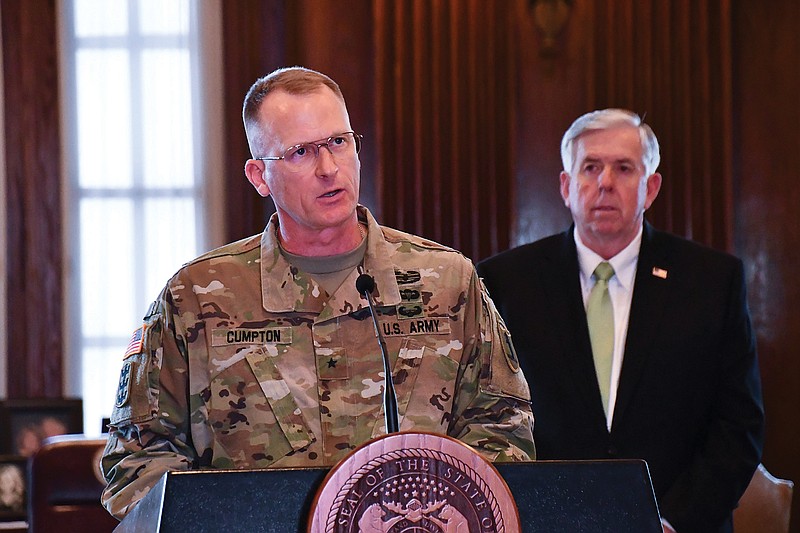Missouri has $66 million available under the CARES Act to help meet the child care needs of families and providers, with millions more from the federal COVID-19 pandemic aid legislation available for crime victims and regional food banks.
The money from the Coronavirus Aid, Relief and Economic Security Act is currently available, said Jennifer Tidball, acting director of the Missouri Department of Social Services.
Temporary changes in eligibility guidelines mean more low-income families can receive help, Gov. Mike Parson said.
Tidball said low-income families searching for work will have access to a 90-day child care benefit through December 2020.
All families who have an income of up to 215 percent of the federal poverty level and who have a documented child care need will be eligible for a transitional child care subsidy benefit through August 2020, Tidball added.
The federal poverty level this year is an income $12,760 for individuals; $17,240 for a family of two; $21,720 for a family of three; and $26,200 for a family of four. Calculations are provided for up to a family of eight. More information on the federal poverty level is available at www.healthcare.gov/glossary/federal-poverty-level-fpl/.
For a family of two, 215 percent of the federal poverty level would be $37,066; for a family of three, $46,698; and for a family of four, $56,330.
A later news release from Parson's office added families who did not previously qualify for a child care subsidy may now be eligible. Families need an income of at least 138 percent of the federal poverty level to be eligible, and parents may be working, attending school or training for work.
For a family of two, 138 percent of the federal poverty level is $23,791; for a family of three, $29,973; and for a family of four, $36,156.
Families who qualify or already receiving the transitional care benefit will receive an 80 percent subsidy if their income is 138-176 percent of the federal poverty level, or a 60 percent subsidy if their income is 177-215 percent of the level, the news release added.
Child care providers also have some expanded access to benefits.
Providers that remain open to provide child care services for essential workers are eligible to receive a one-time payment - based on the number of children they have capacity for - from between $1,000 for serving less than 10 children to $7,500 for serving more than 200 children.
Licensed and license-exempt child care providers that offer non-traditional operating hours - before 6 a.m. and after 7 p.m. on weekdays, and weekend hours - will also be eligible for monthly payments of $100 for each care slot for the months of April, May and June, Tidball said.
Also for those months, child care providers receiving subsidies will be paid based on their authorized level of care, not actual attendance, she said.
Furthermore, Tidball said DSS and the Missouri Department of Higher Education and Workforce Development have partnered to develop on-site child care programs.
Parson's news release said the state has allocated $10 million for one-time grants to colleges and universities to establish on-campus programs that include slots for families receiving child care subsidies.
More information on services available through DSS is available at dss.mo.gov.
Also under the CARES Act, $1.5 million is available to be distributed among Missouri's six regional food banks, including more than $212,000 for the Food Bank for Central & Northeast Missouri.
Another $1.8 million has also been designated to help current recipients of Victims of Crime Act grants, which Tidball said support providers that aid victimized Missourians in child welfare cases, as well victims of domestic violence, sexual assault and other crimes.
Tidball added the state is seeking a waiver for a 20 percent matching requirement. If that waiver is granted, she said that will help providers who have not been able to receive donations or have volunteer hours to document.
Medical care has also been interrupted by the pandemic.
The state began publicly reporting Wednesday analytics of the pandemic on the website of the Department of Health and Senior Services, and the data shows a large decrease in emergency department visits since mid-March, which is when the number of COVID-19 cases began to grow in Missouri and businesses and daily activities began to shut down.
The percentage of emergency department visits for symptoms of COVID-like illness is also trending down and has been since early April, according to the data.
Dr. Randall Williams, director of DHSS, said he expected emergency room visits will start to increase again, as people start seeking care they had been avoiding to get, while symptoms of COVID-19 from community transmission should also continue to decrease.
Williams said pediatricians are also looking to remind parents to resume regular check-ups for their children again.
While the data shows the number of hospitalizations for COVID-19 patients is down 15 percent across the state from where it was in early April, it's also shown that reported hospital bed availability is down.
Williams said the decline in bed availability may be due to a reporting bias - fewer hospitals reporting bed space.
The data is available at health.mo.gov/living/healthcondiseases/communicable/novel-coronavirus/pdf/analytics-update.pdf.
As of Wednesday afternoon, there had been 9,102 reported cases of COVID-19 in Missouri since the first infection in the state announced in early March, with 396 deaths.

